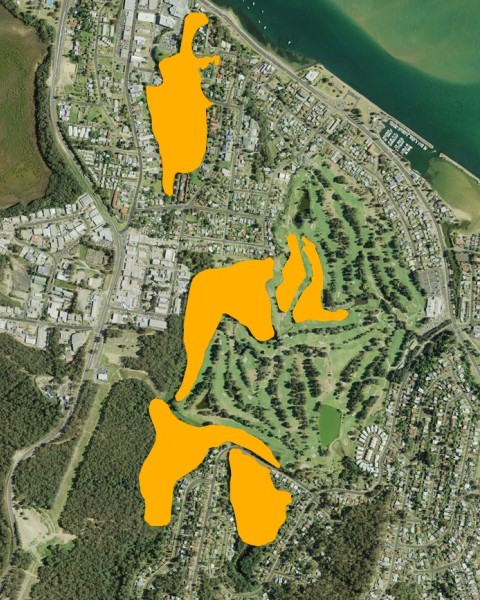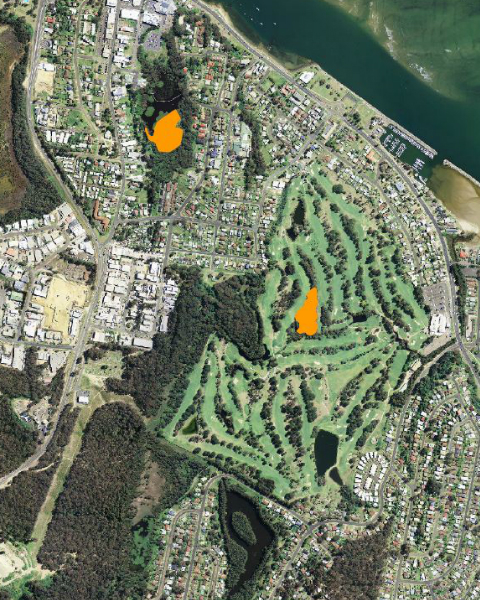Flying-fox populations in Eurobodalla
There are currently nine known flying-fox camps in Eurobodalla. Council has monitored these camps since 2016.
This page outlines the camps' context, history, population, ecological values, and management options.
You can find a full assessment of all camps in Eurobodalla in our Flying-fox Management Plan:
Conflict between flying-foxes and people is likely to increase when these camps are close to homes, towns, hospitals, and schools etc.
We realise there may be other unknown camps in Eurobodalla. While these camps are unknown and not causing any conflict, we will not need to manage them.
Known camps in Eurobodalla
This map shows the locations of flying-fox camps in Eurobodalla.
The flying-foxes live in these camps during the day, and at night they forage for food often travelling long distances.
Flying-fox camp populations
Water Gardens camp - near Batemans Bay township+
- The Water Gardens is a six-hectare wetland park close to the Batemans Bay town centre.
- This camp has had the largest flying-fox population.
- Council manages this land; the flying-fox camp also extends onto private land next to it.
Site and history
- The Water Gardens opened in 1999; a community committee managed the land. The site is:
- a natural drainage area that was once used for stock grazing
- covered with swamp oak floodplain forest vegetation, an Endangered Ecological Community (EEC)
- zoned for environmental conservation.
- In 1989, Council redeveloped the site into a town park.
- In 2012, Council started managing the site. The regrowing vegetation bordered many residential properties around the park.
Flying-foxes - timeline of events
- 2012: Council recorded grey-headed flying-foxes at the Water Gardens. There were reports that small numbers occupied the site before 2012.
- 2013: Council recorded more than 10,000 flying-foxes in the camp.
- 2014: Council recorded more than 20,000 flying-foxes in the camp.
- 2015: Council developed the Water Gardens Grey-headed Flying-Fox Management Plan. The plan outlines the different ways to manage the impacts of flying-foxes on residents and businesses. As part of the plan, we removed the overgrown vegetation at the Water Gardens to reinstate buffers between houses.
- 2016: Eurobodalla had a mass-flowering of spotted gum and red bloodwood in our forests. This flowering attracted hundreds of thousands of flying-foxes to Batemans Bay. After the influx of flying-foxes, Council carried out works, including:
- extended the buffer zones to residences
- weed control and mowing
- removing rubbish
- planting and mulching native shrubs and grasses
- installed a water pump and canopy sprinklers to discourage flying-foxes from roosting in vegetation near houses.
- 2016: Council started monitoring flying-fox numbers after dispersal activities in June.
- 2018: Council developed the Eurobodalla Flying-fox Management Plan.
- 2019: Council recorded less than 5,000 flying-foxes throughout the year.
- 2020: Council recorded a maximum of 1,000 flying-foxes in January.
- 2021: Council recorded no more than 500 flying-foxes in the camp.
- 2022: Council recorded up to 16,000 flying-foxes in May.
- 2023: Council recorded 5,000 flying-foxes from May to July.
- 2024: Council recorded more than 2,000 flying-foxes from January to July.
Northern Catalina camp - on the golf course+
- The camp is at the Club Catalina golf course, along Hanging Rock Creek, Batemans Bay.
- The vegetation at this camp is an EEC - swamp sclerophyll forest on coastal floodplain or coastal swamp oak forest.
- The site is zoned as environmental conservation.
- Council started monitoring the camp in November 2012.
- Council has recorded flying-foxes at this site since 2013. Flying-foxes continue to occupy the camp on occasion, but not every year.
- The largest population at this camp covered 18.74 ha.
Moruya central town camp+
- The camp is on private land at Racecourse Creek, near Moruya Showground.
- The vegetation is a mix of native and exotic species.
- In 2023, the population increased to 5,000 individuals.
- Flying-foxes have occupied the camp in small numbers over the last three years.
Moruya Heads camp+
- The camp is on private land zoned as environmental conservation.
- The vegetation is swamp oak floodplain forest, an EEC.
- In early 2013, the National Flying-fox Monitoring Program recorded 10,000 flying-foxes and in 2015 at the same time, there were 2,000.
- In 2016, Council started monitoring this camp.
- In early 2019, Council recorded 13,000 flying-foxes.
- Flying-foxes occupy the camp on occasions.
Moruya Riverside Park camp+
- The camp is on Council-managed land.
- Council revegetated the land with a mix of native species, including she-oaks.
- In December 2023, flying-foxes started occupying the camp.
- In January 2025, the camp peaked at 10,000 flying-foxes, with a total occupied area of around five hectares.
Moruya east town camp+
- The camp is on private land near Racecourse Creek, south east of the South Head Road roundabout.
- The camp is in Swamp Oak Floodplain Forest EEC.
- In 2023, the population increased to 6,000 individuals.
Tuross Head camp+
- The camp is on vacant privately-owned land on Hector McWilliam Drive.
- The vegetation at the camp is yellow stringybark – coast grey box shrubby open forest on coastal ranges.
- Flying-foxes have occupied the camp since 2017.
- The average camp population covers an area of about 1,500m2.
- The National Flying-Fox Monitoring Program monitored the camp in 2017 as part of its program and counted 100 flying-foxes.
- In 2019, there were up to 3,000 flying foxes, however numbers generally stay around 500.
Potato Point camp+
- The camp is in swamp-oak woodland in Eurobodalla National Park.
- Council has not mapped the extent of this camp.
- Flying-foxes first occupied the camp in 2024, with numbers reaching 4,000 in April and 650 in July
- The camp is close to the town centre but does not cause any problems for residents.
- Council will continue to track camp numbers.
Narooma camp+
The Narooma camp:
- is on public land zoned as environmental conservation and covers around 2.8ha
- has lilly pilly - sassafras, warm temperate rainforest in moist sheltered gullies, an EEC
- is not close to any urban areas
- is part of the National Flying-Fox Monitoring Program
- had a population of about 21,000 flying foxes in May/June 2022 but generally does not have more than 1,000 flying foxes.
Camp comparison and history
Total population trends across all Eurobodalla camps+
Flying-fox influx in 2016+
- In 2016, more than 270,000 flying-foxes swarmed Batemans Bay in response to a mass flowering of spotted gum (Corymbia maculata) and fed bloodwood (Corymbia gummifera). This was about 40% of the entire population we counted in May 2016.
- Spotted gums flower from late autumn through winter, and red bloodwoods flower summer through autumn. In 2016, these species flowered at the same time.
- During the influx, flying-foxes occupied the Water Gardens and Catalina camps. The population also extended into residential areas around the camps and impacted residents.
How we managed the camps
- Council requested approval to carry out dispersal activities. The Minister for the Environment granted a National Interest Exemption. This exemption allowed us to disperse the flying-foxes and manage the vegetation at the camps.
- We were also asked to prepare a Conservation Agreement, which prompted us to develop the Eurobodalla Flying-fox Management Plan:
- In 2016, we also developed the Batemans Bay Flying-fox Camp Dispersal Plan:
- In June and July 2016, we carried out approved flying-fox dispersal activities and numbers started to decrease. We also removed:
- 5.3 hectares of vegetation from the Water Gardens and Catalina to provide buffers for residents
- cocos palms to reduce disturbance from night-time foraging and mess from flying-fox faeces
- weeds, mulched, and planted native shrubs and grasses at the Water Gardens.
2016 to 2019 population comparison
These maps show the extent of the flying-fox camps at their peak in April 2016, and in May 2019.
Click for larger images
The extent of flying-fox camps at their peak in April 2016
The extent of flying-fox camps in Batemans Bay in May 2019
More information
The Department of Climate Change, Energy, the Environment and Water has helpful flying-fox information on their website:
Contact us
To find out more about flying-foxes, contact:
- Council's Natural Resource Management Officer (Flying-Foxes), India Howlett:
- T: 02 4474 7329
- E: India Howlett
- Damon Oliver, Department of Climate Change, Energy, the Environment and Water:
- T: 02 6229 7112



